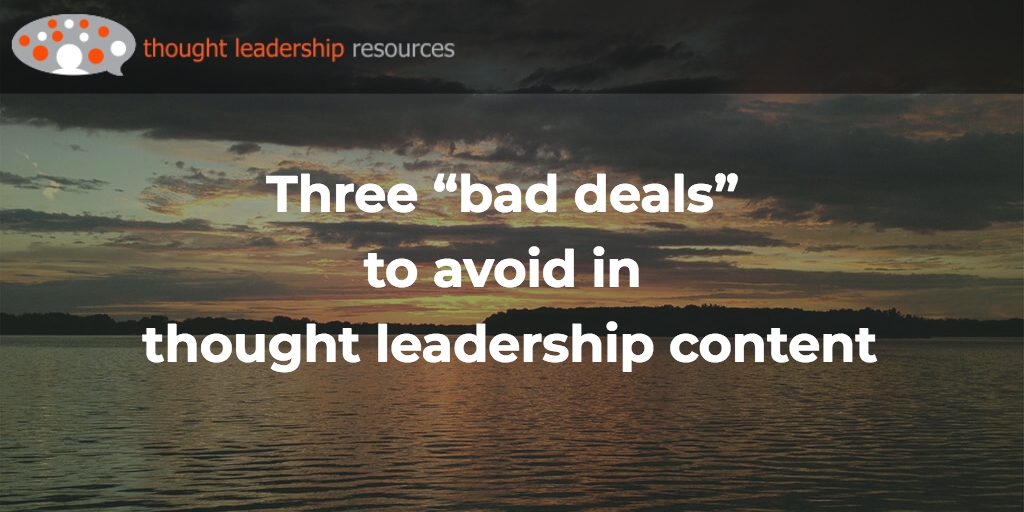So here’s my rogues’ gallery of bad publishing options:
“Buy ad space from us, and you can publish an article for free”
Recently a friend asked me about an opportunity she’d been offered on behalf of her firm. It was the publisher of a new mining magazine, and as it happens, that is the market her firm is pursuing. So, it looked promising. The publisher made my friend an offer that if she bought some ad space, she could get an article published in the magazine at no extra cost. Her question to me was, whether this is a good deal.
So we talked through it, and we agreed that the whole idea didn’t make sense, for three reasons.
1. The publication was new, and didn’t have the readership of the established mining media, where I’ve published dozens of articles over the years. So it seemed that there were better places to put her company’s message. While I’m all in favor of helping small companies get bigger, I also like to get value (in terms of eyeballs) for the articles I write.
2. The “no extra cost” thing didn’t seem worthwhile, because in my experience there are plenty of established, respected mining media eager to publish articles that meet their requirements, with no expectation of buying ad space. “Free article” is kind of like walking into a restaurant and being told that I can breathe their air at no extra cost. Kind of a given, right?
3. They’re willing to publish a sales pitch. I looked through the description of what the publisher was looking for in articles, and it seemed that they’d accept a straight-up sales pitch about my friend’s company’s products. While that might seem like a good thing, it’s a bad thing. The reason: if anyone’s actually reading this publication, the articles in it won’t have much credibility with them, because the readers know that the content has not met the usual editor’s smell test. It has low impact as a result.
This is why the most respected media have a firm wall between the advertising department and the editorial department, just so that readers get what they expect: the straight goods in the articles they read.
So, I suggest: keep your advertising spending separate from your thought leadership articles. Buy ad space if you want, but in my view that’s what you do only if you can’t think of any thought leadership ideas. I’m glad that there are companies willing to pay about US$10,000 a page to get their message in front of the right readers, because it keeps those publications publishing. That gives me space for my clients’ articles.
However, I think articles are a better deal than advertisements (Spend the $10K on a freelance writer instead; you’ll get a lot further :) ). I’ve dug deeper into this topic in Post #82, here.
“We want to publish a profile about your company, at no cost!
The second “bad deal” is one that ensnares many larger firms. A publication editor calls someone senior at the firm, and says that the publication wants to do a profile article about the firm, at no cost, and of course you’ll get a chance to review it before publication. The editor says that it’s a large-circulation publication with audited figures, but somehow, you’ve never heard of it before.
But then the editor makes what may seem an odd request – for a list of the firm’s most important vendors, suppliers and business partners. “We may get in touch with them about the article,” she says mysteriously.
Then you find that the publication’s ad sales people have contacted everyone on the list you gave them, urging them to buy ad space to “support” your profile. Those companies may justifiably feel pressured to buy ad space, because they are dependent on your firm for paying the rent. But they’ll resent the fact that your firm got the free publicity, and they feel that they wound up paying for it.
These “content-supported” publications are generally not read by the people you most want to reach. You’ll risk angering your firm’s business partners, and for the purposes of an article that few people will actually read.
“We’ll publish your message the way you want”
The third “bad deal” is the advertorial. As a regular reader of “Fortune” magazine, I find whole chunks of each issue devoted to these things, and I always flip right past them. Why? I know that it’s paid content, and as a result, I know it’s there to sell me something – either a product, a service or even just an idea.
I expect that advertorials get picked up in Google searches, so they can be a way to give your content a platform. But compared to the effectiveness of publishing content in a way that you don’t have to pay for the space, it’s just not a good use of resources.
Yes, they’ll publish what you want to say. But they’ll charge you, and the people you most want to reach don’t take time reading what they reasonably expect will be a sales pitch.
I still think that publishing expert-written articles in online and print media relied upon by your firm’s ideal clients is the way to go. It helps if your content is focused on the needs of those ideal clients, rather than what your firm wants to sell. One way to do that is through “newsjacking,” which means creating content around news that affects your clients. Post #83 tells you how to do that.


